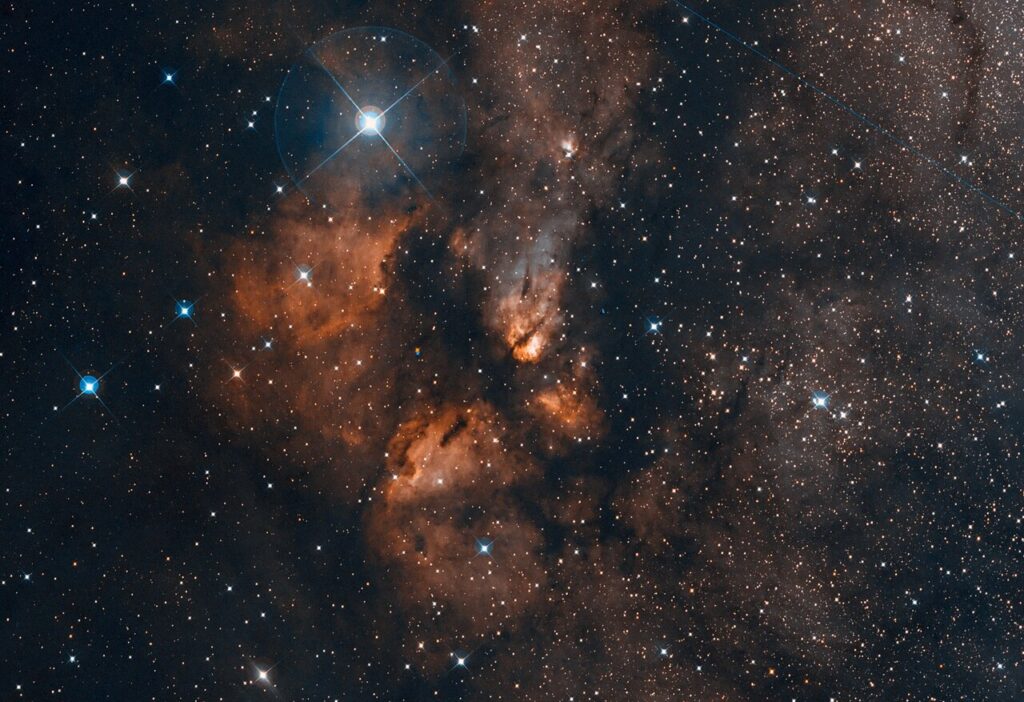The cosmos continues to reveal its hidden beauty, and the latest visual gift from the European Southern Observatory (ESO) is nothing short of breathtaking. The 80-million-pixel image of the RCW 38 star cluster, captured by the Visible and Infrared Survey Telescope for Astronomy (VISTA) in Chile’s Atacama Desert, presents an unprecedented look into one of the Milky Way’s most active stellar nurseries.
A Young and Energetic Cluster
RCW 38 is a young, massive star cluster located 5,500 light-years away in the constellation Vela. Unlike our Sun, which is 4.6 billion years old, the stars in RCW 38 are just a few hundred thousand years old—practically newborns in cosmic terms.

The cluster contains approximately 2,000 stars, many of which are massive, hot, and energetic, radiating immense amounts of ultraviolet (UV) and X-ray energy. These young stars illuminate the surrounding gas and dust, giving rise to the vivid pink hues visible in the ESO image.
Why Infrared Imaging is Crucial
One of the biggest challenges in observing star-forming regions like RCW 38 is the presence of thick clouds of interstellar dust that obscure visible light. In standard optical images, much of the cluster remains hidden. However, infrared telescopes like VISTA can penetrate these dusty regions, revealing previously unseen details about the young stars and their environment.
Infrared imaging allows astronomers to observe protostars—stars that are still forming—inside dense clouds of gas and dust. Additionally, it helps identify brown dwarfs, also known as “failed stars”, which lack sufficient mass to sustain nuclear fusion.
How Stars Are Born in Stellar Nurseries
Star clusters like RCW 38 act as “pressure cookers” for stellar formation. They contain all the key ingredients: dense gas clouds, cosmic dust, and immense gravitational forces. The process unfolds as follows:
- Gravity causes dense pockets of gas and dust to collapse.
- As the material falls inward, it heats up, eventually igniting nuclear fusion—the birth of a star.
- The newborn star emits powerful radiation, which shapes the surrounding nebula, creating breathtaking cosmic structures like the pink-hued clouds in RCW 38.
- Some fragments of the collapsing gas cloud fail to gather enough mass to ignite nuclear fusion, forming brown dwarfs instead.
The Impact of Radiation from Massive Stars
The massive stars in RCW 38 are already influencing their surroundings. Their intense radiation and stellar winds are sculpting the nebula, eroding nearby gas clouds and triggering new waves of star formation. However, these same powerful forces can also disrupt the formation of smaller stars and planetary systems.
How VISTA Captured This Image
VISTA, one of the most advanced infrared telescopes in the world, is located at ESO’s Paranal Observatory. The telescope is equipped with VIRCAM (VISTA InfraRed CAMera), which provides a wider field of view than most infrared cameras, allowing astronomers to capture large celestial structures in remarkable detail.
The VISTA Variables in the Vía Láctea (VVV) survey, responsible for this image, has been instrumental in creating the most detailed infrared map of the Milky Way ever produced. This survey has helped astronomers:
- Discover new celestial objects hidden within dust clouds.
- Study variable stars—stars whose brightness changes over time.
- Map the structure of the Milky Way in greater detail than ever before.
The Retirement of VIRCAM and Future Upgrades
Following this groundbreaking image, VIRCAM was officially retired in 2025 after an impressive 17-year run. However, the telescope is set to receive a new instrument called 4MOST, which will be capable of gathering spectra from 2,400 objects simultaneously. This next-generation tool will allow astronomers to analyze the physical properties of a vast number of celestial objects with unparalleled efficiency.
Why This Discovery is Important
1. Expanding Our Understanding of Star Formation
Observing star-forming regions like RCW 38 helps scientists understand how stars—and eventually planets—form in our galaxy. This provides clues about the origins of our own Sun and solar system.
2. Studying the Life Cycle of Stars
By studying young stars and their interactions with their environment, astronomers can predict how massive stars evolve and how their explosive deaths (supernovae) impact future star formation.
3. Uncovering Hidden Cosmic Structures
Thanks to VISTA’s infrared capabilities, we can now see previously hidden brown dwarfs, protostars, and star clusters, significantly expanding our catalog of known celestial objects.
4. Advancing Infrared Astronomy
The success of the VVV survey proves the crucial role of infrared telescopes in modern astronomy. Future observatories, such as the James Webb Space Telescope (JWST), will continue this legacy by providing even deeper insights into the universe’s most mysterious regions.
Conclusion: A New Era in Stellar Exploration
ESO’s latest image of RCW 38 is far more than a stunning celestial portrait—it is a groundbreaking scientific achievement that expands our understanding of the universe. By peering through thick cosmic dust, astronomers can now study the hidden processes behind star formation, uncovering the secrets of stellar nurseries like never before.



















